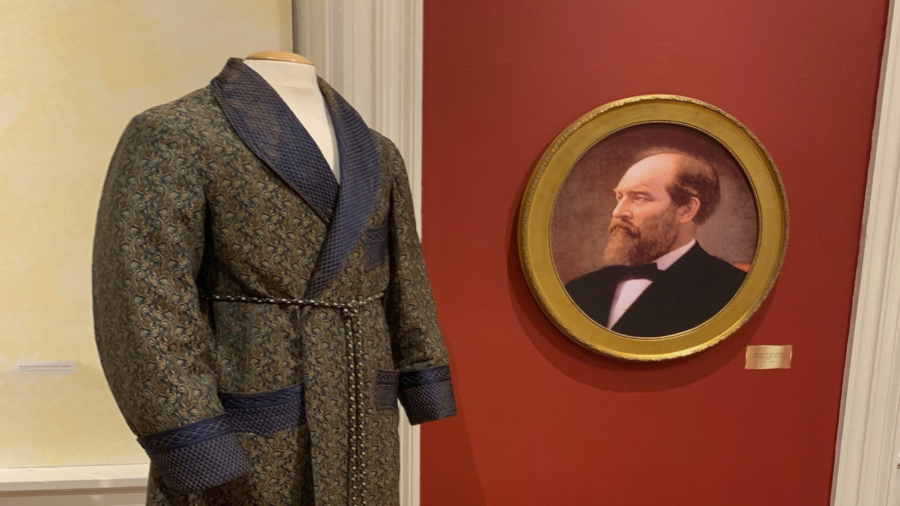COLUMBUS, Ohio—The role of Ohio’s formidable run of early U.S. presidents in establishing many of the nation’s lasting White House customs—from the frolicsome Easter Egg Roll to the presidential war room—is explored in a new history exhibition running through late December.
“The Ohio Presidents: Surprising Legacies” opened this month at the Decorative Arts Center of Ohio, located in Lancaster, about 30 miles southeast of Columbus. The exhibit, which will run through Dec. 29, showcases a roughly 80-year period beginning in 1840 when Ohio and its resident presidents were at the center of the nation’s political and cultural life, allowing visitors to view them as a group.
“We’re highlighting some of the things about their lives and careers that aren’t typically known by the general public,” said curator Christine Fowler Shearer. “We’ve tried to find fun facts and things that aren’t common knowledge.”
Like the start of the official presidential egg roll under President Rutherford B. Hayes and his wife, Lucy, in 1878. Or the role of President Benjamin Harrison’s wife, first lady Caroline Harrison, in placing the first White House Christmas tree in 1889 and initiating the tradition of a White House china collection.
“Many of the different things that we take for granted in some respects, when we hear about them on the news, were actually started by the presidents from Ohio,” Shearer said.
It was an era, the Gilded Age, whose presidents are largely forgotten, said Dustin McLochlin, a historian at the Rutherford B. Hayes Presidential Library and Museums in Fremont, Ohio.
“They’re bearded guys, old Civil War soldiers, and generals, in a period when the presidency isn’t as powerful as it is today,” he said. “What the Ohio presidents really speak to, if you’re going to talk to them as a whole, is it’s an era when Ohio is so important to winning an election, particularly to the Republican Party.”
Objects, artifacts, and photographs displayed throughout the center’s upper galleries were assembled from items gathered from the Library of Congress, Ohio History Connection, Western Reserve Historical Society and elsewhere. The show highlights four aspects of each president’s life: their home life, campaign, time at the White House and death, Shearer said.
Visitors will find James A. Garfield’s bathrobe, as well as Warren G. Harding’s silk pajamas on display. There are hats and fans, china, walking sticks, furniture, historic campaign materials, and other personal items.

The first Ohio president, Benjamin Harrison’s grandfather William Henry Harrison, was the nation’s ninth president and the first to die in office. The general is also known as “Old Tippecanoe,” he died just 31 days into his term of typhoid, pneumonia and paratyphoid fever, prompting the first protocols for replacing a sitting president who dies. William McKinley, president from 1897 to 1901, had the first war room.
It was perhaps no coincidence that the elder Harrison is also known for delivering the longest inaugural address on record—in the rain without a coat, Shearer said.
A timeline accompanying the exhibit begins with William Henry Harrison’s election in 1840 and runs through the death of President Warren G. Harding, the last of the group, in 1923.
As McLochlin notes, five of the Ohio presidents served in the Civil War. The other three—beginning with McKinley in 1897—served in what’s considered the modern American era. Shearer said that the exhibition includes a Civil War re-enactment scene and insights drawn from the Ohio presidents’ administrations into how the nation changed from before to after the war.
McLochlin said, at the time, Ohio was one of only three swing states—along with New York and Indiana. That helps explain Ohio’s outsized place in the presidential politics of the era. Benjamin Harrison was a “two-for-one guy,” because he was born in Ohio and spent his adult life in Indiana.
Yet Hayes, in particular, read the Constitution as giving the president a more modest role than big personalities, beginning with President Teddy Roosevelt, who would come later, he said. He was one of only two presidents who chose to seek only one term.
“He really felt that his role was not to overshadow Congress, but to work with Congress,” McLochlin said. “Some would say that’s eroded over the years.”
The elder Harrison was born in Virginia but lived most of his adult life in Ohio. The others—which also include Ulysses S. Grant, president from 1869 to 1877; and William Howard Taft, president from 1909 to 1913—were all Ohio natives.
William Henry Harrison wasn’t the only Ohio president to meet a tragic end. Both Garfield and McKinley were assassinated—Garfield about six months after taking office in 1881, and McKinley about six months into his second term in 1897. Harding was in the third year of his term in 1923 when he died of a heart attack.
Shearer said the exhibit features installments on the presidents’ deaths in part for that reason. It also highlights the lives and work of their wives.
Taft’s great-grandson, former Ohio Gov. Bob Taft, will appear at an Oct. 20 program associated with the exhibit. It will explore three “very modern” first ladies: Lucy Webb Hayes, Helen “Nellie” Herron Taft, and Florence Kling Harding.
An ancillary mini-installation drawn from the Ohio History Collection’s archives spotlights glass and ceramic plates, cups, pitchers and flasks inspired by the eight Ohio presidents and President Andrew Jackson.
By Julie Carr Smyth

